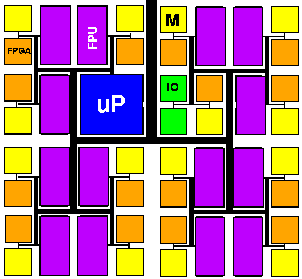Programmable System-on-a-Chip Architecture
 |
 |
Heterogeneous PSOC
with uP, FPGA, and
Memory |
Heterogeneous PSOC
with uP, FPGA, FPU, and
Memory |
| With the silicon capacity available today, ISA-based,
general-purpose processors are hitting a point of diminishing
returns---where it is hard for them to fully exploit the available
silicon. At the same time, we're seeing evidence that spatial
architectures (e.g. FPGAs) can provide higher performance per unit area
than processors for many regular applications while still providing a
programmable substrate. In general, today's IC's are large enough to
easily contain a rich collection of uP's, spatial array logic, memory, and
specialized processing units. This raises several important questions: How
do we navigate this new design space enabled by modern silicon capacity?
How do we combine these diverse components in a systematic way? What
abstraction(s) should replace the ISA, giving the user and compiler a
robust fixed point, while allowing implementations to scale and exploit
the inevitable and regular increase in silicon capacity?
For a look at the role of spatial architectures, see The Density
Advantage of Configurable Computing and Fundamental
Underpinnings of Reconfigurable Computing Architectures. For our initial ideas on a
compute model and abstractions for Programmable System-on-a-Chip designs,
see the SCORE
tutorial and GraphStep. |
![]()
|

